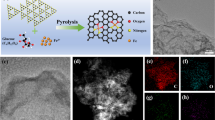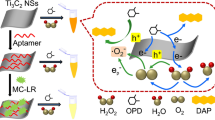Abstract
An Au-based nanozyme composite (AuNPs/Cu,I) was constructed by using Cu,I-doped carbon dots (Cu,I-CDs) as the reducing agent as well as the nanozyme. Notably, AuNPs/Cu,I nanozyme not only possessed the intrinsic activity of mimicking enzymes of superoxide dismutase, peroxidase, and catalase at different conditions but was also employed as surface-enhanced Raman spectroscopy (SERS) enhancer. The combination of Cu,I-CDs and AuNPs promoted the electron transferability, leading to increased peroxidase-like activity and superoxide-like activity. Compared to the individual Cu,I-CDs and AuNPs nanozyme, the AuNPs/Cu,I composite demonstrated promising peroxidase-like activity by transferring electrons instead of generating OH. Interestingly, the multienzyme-like activity of AuNPs/Cu,I nanozyme could be finely tuned by changing the composition of Cu0/Cu+ and Au. The tert-butyl hydroquinone (TBHQ) as the substrate could be catalyzed with AuNPs/Cu,I nanozyme to produce red substances, resulting in a significant Raman enhancement effect at the same time, showing good linear range from 0.11 to 10 mg L−1. Overall, the current investigation provides a flexible and controllable way to design multifunctional nanozymes along with the Raman enhancement strategy based on the catalysis of nanozyme.
Graphical abstract





Similar content being viewed by others
References
Zhang R, Fan K, Yan X (2020) Nanozymes: created by learning from nature. Sci China Life Sci 63:1183–1200. https://doi.org/10.1007/s11427-019-1570-7
Gao L, Yan X (2016) Nanozymes: an emerging field bridging nanotechnology and biology. Sci China Life Sci 59:400–402. https://doi.org/10.1007/s11427-016-5044-3
Lin Y, Ren J, Qu X (2014) Nano-gold as artificial enzymes: hidden talents. Adv Mater 26:4200–4217. https://doi.org/10.1002/adma.201400238
Wu J, Qin K, Yuan D, Tan J, Zhang X, Wei H (2018) Rational design of Au@Pt multibranched nanostructures as bifunctional nanozymes. ACS Appl Mater Interfaces 10:12954–12959. https://doi.org/10.1021/acsami.7b17945
Chen F, Bai M, Cao K, Zhao Y, Wei J, Zhao Y (2017) Fabricating MnO2 nanozymes as intracellular catalytic DNA circuit generators for versatile imaging of base-excision repair in living cells. Adv Funct Mater 27:1702748. https://doi.org/10.1002/adfm.201702748
Fan K, Wang H, Xi J, Liu Q, Meng X, Duan D, Gao L, Yan X (2017) Optimization of Fe3O4 nanozyme activity via single amino acid modification mimicking an enzyme active site. Chem Commun 53:424–427. https://doi.org/10.1039/c6cc08542c
Li F, Chang Q, Li N, Xue C, Wang H (2020) Carbon dots-stabilized Cu4O3 for a multi-responsive nanozyme with exceptionally high activity. Chem Eng J 394:125045. https://doi.org/10.1016/j.cej.2020.125045
Yang DZ, Chen Z, Gao S, Tammina K, Yang Y (2020) Nanozymes used for antimicrobials and their applications. Colloids Surf B 195:111252. https://doi.org/10.1016/j.colsurfb.2020.111252
Liu H, Li Y, Sun S, Xin Q, Liu S, Mu X, Yuan X, Chen K, Wang H, Varga K, Mi W, Yang J, Zhang XD (2021) Catalytically potent and selective clusterzymes for modulation of neuroinflammation through single-atom substitutions. Nat Commun 12:114. https://doi.org/10.1038/s41467-020-20275-0
Zhang H, Yang KL (2020) In situ formation and immobilization of gold nanoparticles on polydimethylsiloxane (PDMS) exhibiting catalase-mimetic activity. Chem Commun 56:6416–6419. https://doi.org/10.1039/D0CC01344G
Lin S, Cheng Y, Zhang H, Wang X, Zhang Y, Zhang Y, Miao L, Zhao X, Wei H (2020) Copper tannic acid coordination nanosheet: a potent nanozyme for scavenging ROS from cigarette smoke. Small 16:e1902123. https://doi.org/10.1002/smll.201902123
Yang D, Tammina SK, Yang Y (2019) Enhanced removal and detection of benzo[a]pyrene in environmental water samples using carbon dots-modified magnetic nanocomposites. Ecotoxicol Environ Saf 170:383–390. https://doi.org/10.1016/j.ecoenv.2018.11.138
Yang D, Li Q, Tammina SK, Gao Z, Yang Y (2020) Cu-CDs/H2O2 system with peroxidase-like activities at neutral pH for the co-catalytic oxidation of o-phenylenediamine and inhibition of catalytic activity by Cr(III). Sens Actuators B 319:128273. https://doi.org/10.1016/j.snb.2020.128273
Chen B, Li F, Weng S, Zheng Z, Chen M, Wu W, Lin X, Yang C (2018) Positive carbon dots with dual roles of nanoquencher and reference signal for the ratiometric fluorescence sensing of DNA. Sens Actuators B 264:193–201. https://doi.org/10.1016/j.snb.2018.02.175
Ouyang L, Mu X, Wang J, Li Q, Zhang XD (2020) Carbon dot targeting to nitrogen signaling molecules for inhibiting neuronal death. J Mater Chem B 8:2321–2330. https://doi.org/10.1039/C9TB02447F
Guo Y, Liu X, Wang X, Iqbal A, Yang C, Liu W, Qin W (2015) Carbon dot/NiAl-layered double hydroxide hybrid material: facile synthesis, intrinsic peroxidase-like catalytic activity and its application. RSC Adv 5:95495–95503. https://doi.org/10.1039/C5RA18087B
Liu N (2014) One-step catalase controllable degradation of C3N4 for N-doped carbon dot green fabrication and their bioimaging applications. J Mater Chem B 2:5768–5774. https://doi.org/10.1039/C4TB00772G
Bourlinos AB, Stassinopoulos A, Anglos D, Zboril R, Karakassides M, Giannelis EP (2018) Surface functionalized carbogenic quantum dots. Small 4:455–458. https://doi.org/10.1002/smll.200700578
Li F, Li N, Xue C, Wang H, Hu S (2020) A Cu2O-CDs-Cu three component catalyst for boosting oxidase-like activity with hot electrons. Chem Eng J 382:122484. https://doi.org/10.1016/j.cej.2019.122484
Sun C, Dong W, Peng J, Wan X, Sun Z, Li D, Wang S (2020) Dual-mode fluorescence–SERS sensor for sensitive and selective detection of uranyl ions based on satellite Fe3O4-Au@CdTe nanostructure. Sens Actuators B 325:128644. https://doi.org/10.1016/j.snb.2020.128644
Lim SY, Shen W, Gao Z (2015) Carbon quantum dots and their applications. Chem Soc Rev 44:362–381. https://doi.org/10.1039/C4CS00269E
Fujita S, Abe M, Shibuya M, Yamamoto Y (2015) Intramolecular hydroalkoxylation of unactivated alkenes using silane–iodine catalytic system. Org Lett 17:3822–3825. https://doi.org/10.1021/acs.orglett.5b01797
Zhang S, Liu X, Li Z, Hao L, Wang P, Zou X, Liu Z, Zhang G, Zhang C-Y (2019) Iron and iodine co-doped triazine-based frameworks with efficient oxygen reduction reaction in alkaline and acidic media. ACS Sustainable Chem Eng 7:11787–11794. https://doi.org/10.1021/acssuschemeng.9b02073
Duan Y, Huang Y, Chen S, Zuo W, Shi B (2019) Cu-doped carbon dots as catalysts for the chemiluminescence detection of glucose. ACS Omega 4:9911–9917. https://doi.org/10.1021/acsomega.9b00738
Gan H, Han W, Fu Z, Wang L (2021) The chain-like Au/carbon dots nanocomposites with peroxidase-like activity and their application for glucose detection. Colloids Surf B 199:111553. https://doi.org/10.1016/j.colsurfb.2020.111553
Chen S, Lee HB, Penn RL (2019) Using polyvinylpyrrolidone and citrate ions to modify the stability of Ag NPs in ethylene glycol. J Phys Chem C 123:12444–12450. https://doi.org/10.1021/acs.jpcc.9b00339
Ahmed SR, Kim J, Tran VT, Suzuki T, Neethirajan S, Lee J, Park EY (2017) In situ self-assembly of gold nanoparticles on hydrophilic and hydrophobic substrates for influenza virus-sensing platform. Sci Rep 7:44495. https://doi.org/10.1038/srep44495
Zhao W, Jia W, Sun M, Liu X, Zhang Q, Zong C, Qu J, Gai H (2016) Colorimetric detection of Cu2+ by surface coordination complexes of polyethyleneimine-capped Au nanoparticles. Sens Actuators B 223:411–416. https://doi.org/10.1016/j.snb.2015.09.119
Cui Y, Lai X, Liang B, Liang Y, Wang L (2020) Polyethyleneimine-stabilized platinum nanoparticles as peroxidase mimic for colorimetric detection of glucose. ACS Omega 5:6800–6808. https://doi.org/10.1021/acsomega.0c00147
Wang C, Shi Y, Dan Y-Y, Nie X-G, Li J, Xia X-H (2017) Enhanced peroxidase-like performance of gold nanoparticles by hot electrons. Chem Eur J 23:6717–6723. https://doi.org/10.1002/chem.201605380
Chen J, Ma Q, Li M, Wu W, Huang L, Liu L, Fang Y, Dong S (2020) Coenzyme-dependent nanozymes playing dual roles in oxidase and reductase mimics with enhanced electron transport. Nanoscale 12:23578–23585. https://doi.org/10.1039/D0NR06605B
Jiang D, Ni D, Rosenkrans ZT, Huang P, Yan X, Cai W (2019) Nanozyme: new horizons for responsive biomedical applications. Chem Soc Rev 48:3683–3704. https://doi.org/10.1039/C8CS00718G
Zhou Y, Liu B, Yang R, Liu J (2017) Filling in the gaps between nanozymes and enzymes: challenges and opportunities. Bioconjug Chem 28:2903–2909. https://doi.org/10.1021/acs.bioconjchem.7b00673
Wei H, Wang E (2013) Nanomaterials with enzyme-like characteristics (nanozymes): next-generation artificial enzymes. Chem Soc Rev 42:6060–6093. https://doi.org/10.1039/C3CS35486E
Dong JL, Song L, Yin JJ, He W, Wu Y (2014) Co3O4 Nanoparticles with multi-enzyme activities and their application in immunohistochemical assay. ACS Appl Mater Interfaces 6:1959–1970. https://doi.org/10.1021/am405009f
Chen TM, Wu XJ, Wang JX, Yang GW (2017) WSe2 few layers with enzyme mimic activity for high-sensitive and high-selective visual detection of glucose. Nanoscale 9:11806–11813. https://doi.org/10.1039/C7NR03179C
Chen T, Zou H, Wu X, Liu C, Situ B, Zheng L, Yang G (2018) Nanozymatic antioxidant system based on MoS2 nanosheets. ACS Appl Mater Interfaces 10:12453–12462. https://doi.org/10.1021/acsami.8b01245
Faúndez M, Rojas M, Bohle P, Reyes C, López-Alarcón C (2011) Pyrogallol red oxidation induced by superoxide radicals: application to evaluate redox cycling of nitro compounds. Anal Biochem 419:284–291. https://doi.org/10.1016/j.ab.2011.08.048
Han M, Lu H, Zhang Z (2020) Fast and low-cost surface-enhanced Raman scattering (SERS) method for on-site detection of flumetsulam in wheat. Molecules 25:4662. https://doi.org/10.3390/molecules25204662
Deraedt C, Salmon L, Gatard S, Ciganda R, Hernandez R, Ruiz J, Astruc D (2014) Sodium borohydride stabilizes very active gold nanoparticle catalyst. Chem Commun 50:14194–14196. https://doi.org/10.1039/C4CC05946H
Funding
This work was greatly supported by the Analysis and Testing Foundation of Kunming University of Science and Technology (grant numbers 2019P20173118001) and Research on the Key Technology of Vegetable Deep Processing (grant numbers 2019ZG001-4–2). Yang Dezhi gratefully acknowledges financial support from Kunming University of Science and Technology high-level talent research platform construction funding (grant numbers 20200097) and 2019 Kunming University of Science and Technology Graduate Research and International Exchange Project Fund and Yunnan Lunyang Technology Co., Ltd.
Author information
Authors and Affiliations
Corresponding author
Ethics declarations
Conflict of interest
The authors declare no competing interests.
Additional information
Publisher’s note
Springer Nature remains neutral with regard to jurisdictional claims in published maps and institutional affiliations.
Supplementary Information
Below is the link to the electronic supplementary material.
Rights and permissions
About this article
Cite this article
Yang, D., Li, Q., Zhang, Q. et al. A multifunctional nanozyme-based enhanced system for tert-butyl hydroquinone assay by surface-enhanced Raman scattering. Microchim Acta 189, 29 (2022). https://doi.org/10.1007/s00604-021-05135-y
Received:
Accepted:
Published:
DOI: https://doi.org/10.1007/s00604-021-05135-y




